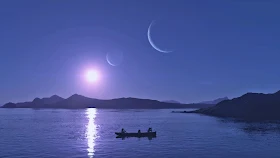For Terrence Malick
At first I have discovered the films by
Guzman and Malick independent from each other. Guzman is as
well the chronicler of this short-lived but probably one of the most
important movement for social justice in the history, the Undidad
Popular Movement in Chile. His La Batalle de Chile is one of
the exemplary political documentaries in the history of cinema and
like Malick, also Guzman was in his late Thirties already a living
legend of cinema. When Guzman connects later his personal history,
the history of his country (he had to leave for a long time) and the
history of the universe in his wonderful Nostalgia De La Luz,
he created something like the documentary pendant to Malick´s The
Tree of Life. I have to admit again that it was this
groundbreaking essay “Great Events and Ordinary People” on The
Tree of Life, published on the Fipresci website which inspired me
to have a different look on these two filmmaker.
Quite an irony – a Berlin film critic
called Guzman´s El Botón de Nacár “esoteric”, one of my
most hated terms when it comes to critic´s reactions on films by
Terrence Malick. First of all, the last films by Guzman and Malick
are love letters to the matter we are all made of. As poetic as it
sounds it is since a long time an undoubted fact that we are made of
stardust.
El Botón de Nacár is among so
much a film about water, as a source of life but also as a source of
what we call civilization. Water is everywhere, even in far distant
galaxies or in comets which pass by our planet. But this film offers
also an ethnographic look on a native tribe from Patagonia which had
once – and ages before the invention of any optical devices – a
profound knowledge and understanding of the universe they saw
reflected in water. Those were astronomers from a far distant past
where a telescope was not even dreamt of but as well about people
with an understanding of cinema long before a photo camera was even
dream of.
If Nostalgia De La Luz looks
like the documentary pendant to Malick´s The Tree of Life
than El Botón de Nacár could be seen partly as a non-fiction
pendant to The New World. Guzman looks at the traces of these
disappeared Natives with boundless admiration. These natives were
also famous for their body paintings only recorded on old drawings
and photographs which also reflected their astonishing understanding
of the universe without no device but their eyes opposite to the
devices Guzman as a filmmaker and the astronomers can benefit from
today. It is the same look of admiration we have in The New World
in this Ophüls-like dance between the perfect apparatus of cinema
and the native girl Pocahontas – and here Malick´s and Lubezki´s
look to a past of cinema long before the apparatus of cinema was
even dreamt of.
The disappearance of the natives in El
Botón de Nacár and the disappearance of the natives in The
New World caused by economical and political motivated
colonialism is for both filmmaker a tragedy because mankind deleted a
big part of its own collective memory full of knowledge.
Martin Scorsese once mentioned that
cinema is often a look into the past and it is often a look into the
past to a world we have lost but where we still can learn from.
It is interesting and also daring that
Guzman uses beside astronomic film footage, his own recorded images
also animated footage. For some purists a tabu is broken, for me this
is nothing less than the evidence that Guzman is both a chronicler
and a poet.
We have in Berlin an impressive
Holocaust-monument. As impossible it is to imagine the worst genocide
in the history of mankind, these empty and silent stones give you at
least an idea about the loss of millions of identities deleted from
the collective memory like through a Black Hole, a metaphor Guzman
will use later in his film when he reveals the victims of the
Pinochet´s dictatorship which are tortured, killed and thrown into the
ocean, bound on steel from demolished railways. After 40 years there
only small traces of human remains left on this steel.
The artificial devices of cinema and
astronomy is not necessary to see what is but to regain what we have
lost or forgotten.
The water, the stars, the old
photographs, the steel of demolished railways, the pearl button as
the last witness of a murdered victim are images which are burnt into
my memory. The look into the past of the universe, the past of the
history of Chile or the past of disappeared natives is like a look at
an infinite screen. El Botón De Nacár is a film often hard
to bear. Moments of great beauty alternate with moments of horror and
grieve.
I remember the third part of La
Batalle de Chile which is also a look into the past. While part 2
ends with the decline of the Unidad Popular and with the suicide of
Salvador Allende, the third part is a long elegy of loss. His most
recent films Nostalgia De La Luz and El Botón de Nacár
leave a very likely echo in me.
On this very Sunday during this Berlin
Film festival I have seen these two unforgettable films by Terrence
Malick and Patricio Guzman. Two days later when I write these lines
on Guzman´s wise, beautiful and very sad masterpiece – I have the
strong and rare feeling that I witnessed film history on this very
day.
Rüdiger Tomczak
Screening:
Sun, Febr 15, Haus der Berliner Festspiele, 10.00

No comments:
Post a Comment